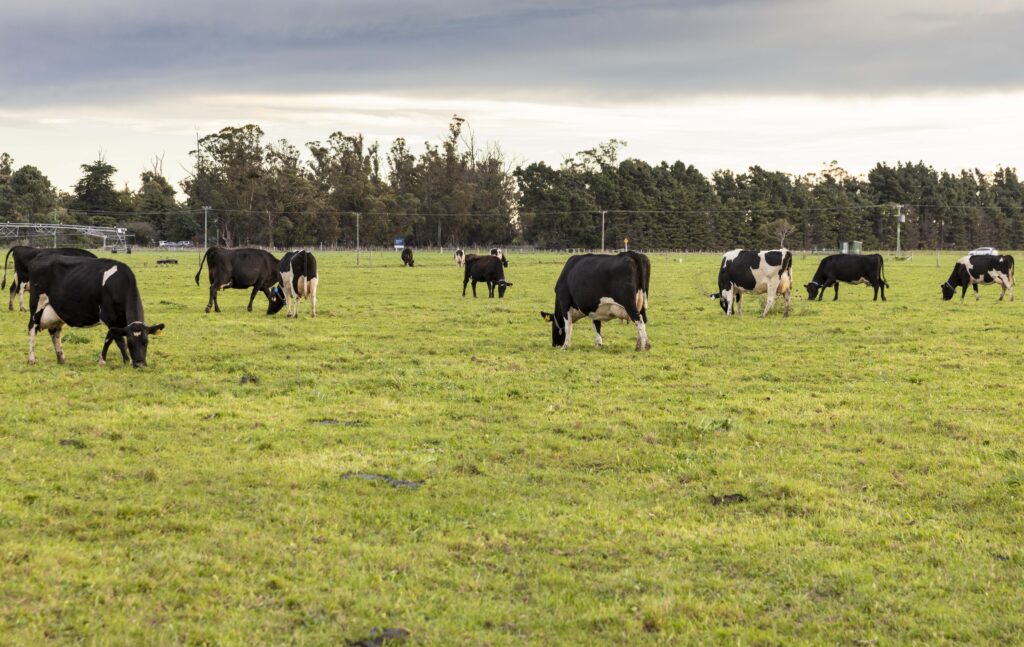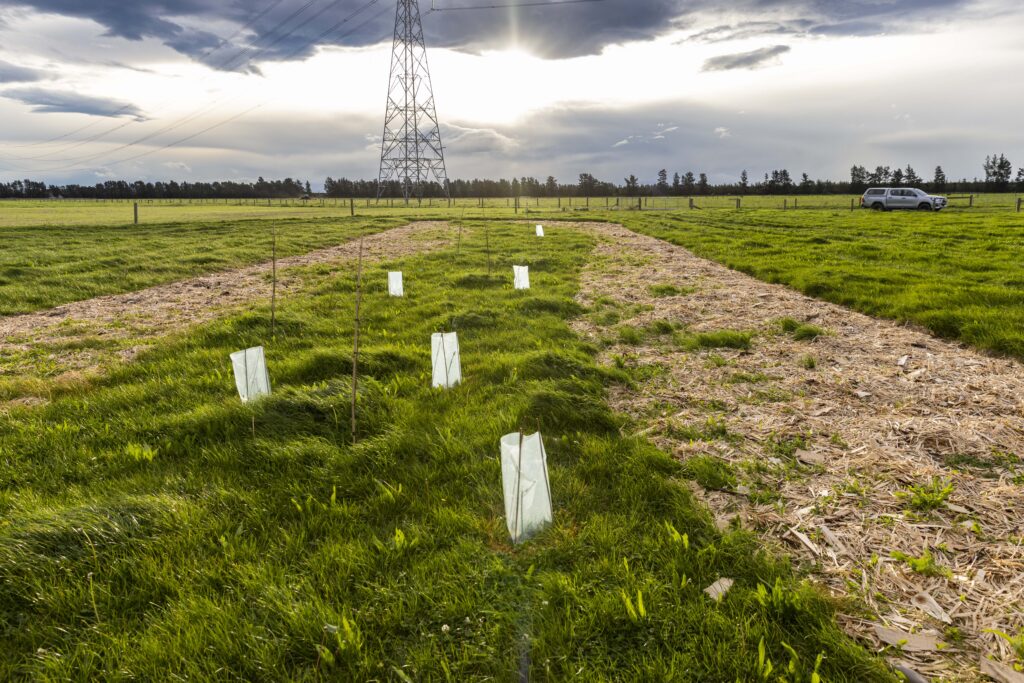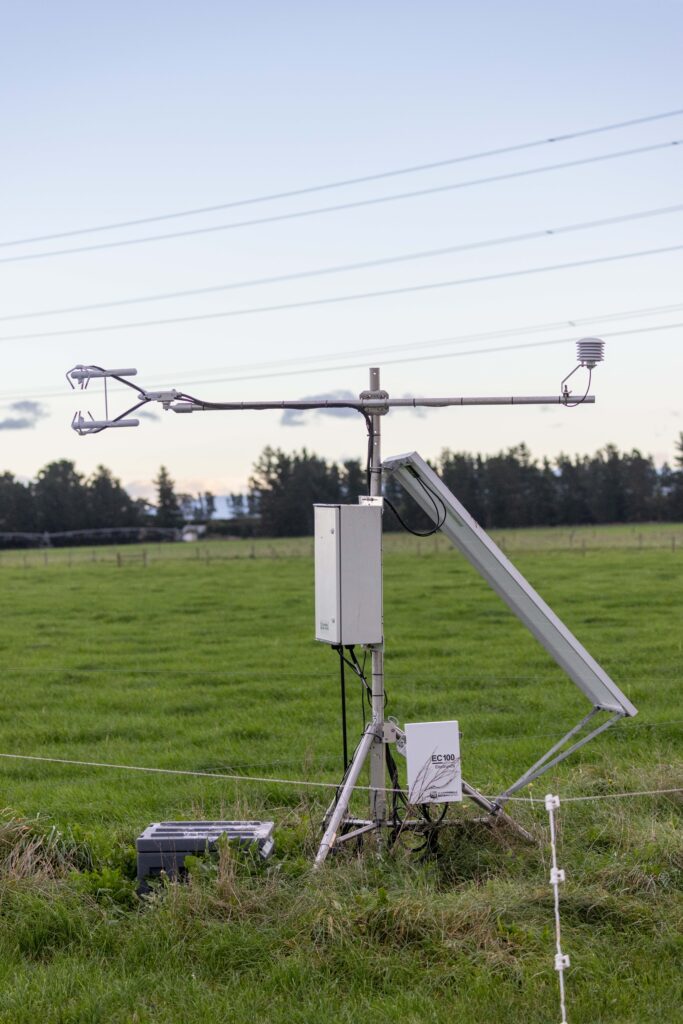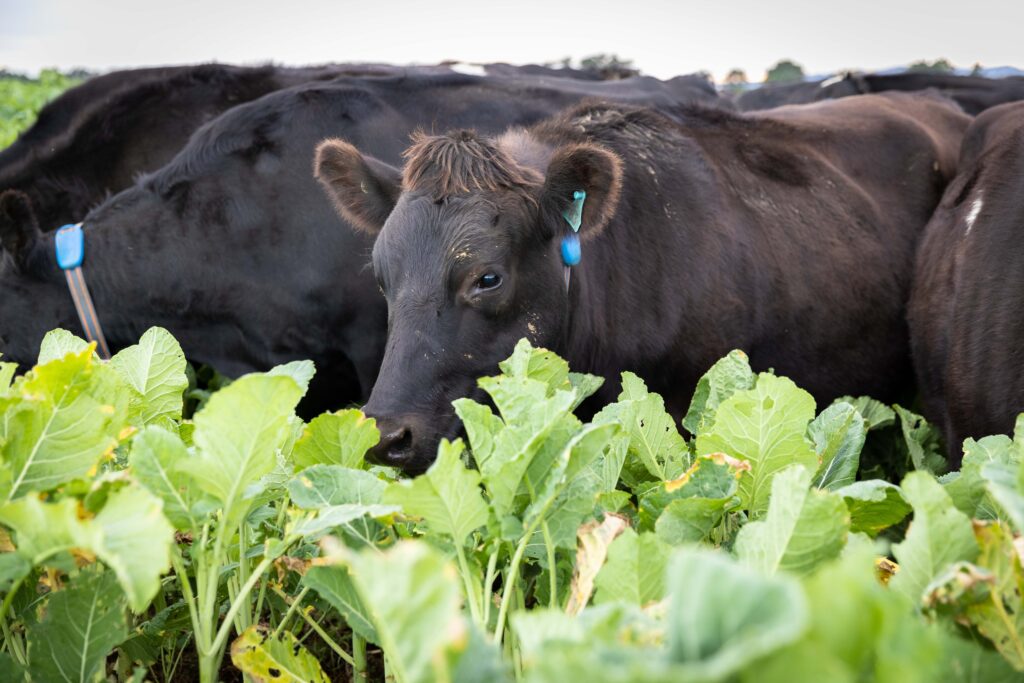Lincoln University Professor Pablo Gregorini would like New Zealand dairy farming to be redesigned as a system that puts health before production, thereby changing the minds of farming sceptics while helping farmers to make more money.
“What we are trying to do is change our general mindset,” Gregorini says.
“We are changing the way we are thinking of farming, changing paradigms, going from pure productivism to more a holistic approach where we are still making money.”
Practically, that means taking a new close and scientific look at everything on the farm – the soil, plants, animals and people as well as the environment and the wider community – and using proven research from New Zealand and overseas to design and test a radically different way of dairy farming.
“We started with a white canvas and spent almost a year with a multidisciplinary and international design team comprising landscape ecologists, landscape architects, animal, plant and social scientists, academics and youth to determine what are the demands, who are the stakeholders in the new system — the university, the animals and plants, the farmer and society — and what are the primary and secondary requirements of those to design a transformational farm focused on health,” Gregorini says.
The idea was to design a way of farming that better addresses the multiple needs of all those stakeholders, enhances farming’s standing in the community and satisfies an increasingly picky market.
“We evaluated all the requirements democratically, so the requirement of a cow is as important as the requirement of the farmer or the requirement of the soil or the environment, and only by that could we then provide solutions and tools we can use to fulfil that demand and get into the position of a farm that produces health rather than a simple commodity, milk.”
The Integral Health Dairy Farm project is led by Gregorini with Dr Anita Fleming as research manager. Gregorini describes himself as “a Kiwi with an Argentinian accent”.
He’s been in New Zealand for 16 years, and previously worked for Wageningen University in the Netherlands, the Department of Agriculture in the United States and the Institute of Grasslands and Environmental Research in the United Kingdom, as well as DairyNZ.
He is now professor of livestock production and agricultural systems at Lincoln University, as well as the director of the university’s Pastoral Livestock Production Lab and head of Lincoln’s Centre of Excellence for Designing Future Productive Landscapes.
He also serves on the boards of a variety of international agricultural scientific organisations.
“We have projects here in New Zealand with all farming systems, beef and lamb, deer and dairy. We have project in the States, Norway and in Brazil with the same story, looking at future productive landscapes and integrative agricultural systems.”
Gregorini says he’s open to pretty much any idea, as long as it’s based on published scientific research and Māori knowledge. He’s quick to distance himself from comparisons between regenerative and conventional agriculture proponents.
“My team is way beyond the futile discussion between being regen or conventional. I think it is a waste of time and there are a lot of egos involved.
“Saying, ‘I am this and you’re that, I’m good, you’re bad’, in my opinion is a futile discussion that only wastes farmers’ time and investment and funding to prove or disprove something. We all want to help our environment; we all want to make money and we all want to motivate youth to go farming.”

The goal is a farm with health as its core value, way ahead of production for production’s sake, and that means it will be quite different from a conventional farm, but Gregorini believes it will provide answers for farmers facing changing market demands and environmental challenges.
“We are playing Rubik’s Cube, focusing on all the faces at the same time rather than one single one because if we do one single one, the silver bullet approach, we are not going to win the game and we probably will stop playing.”
Gregorini describes the 43ha, 100-cow farmlet as “one place, many stories” and says his team is looking at everything, from bottom to top, through different lenses.
“The first lens we look through is the soil. We’re building health from the ground up. The second lens is the plant, then the animal, the human and the society – and only by looking at that place through all those lenses simultaneously you can have a really multi-dimensional approach … you can see health.”
Health is firmly at the centre of the project – health as defined by the World Health Organisation: “A state of complete physical, mental and social wellbeing and not merely the absence of disease or infirmity.”
The Integral Health Dairy Farm is being set up on Lincoln’s Ashley Dene Research and Development Station.
Ashley Dene was depopulated in 2020 because of Mycoplasma bovis, and on that clean slate, new research projects have been launched.
Work has started on a five-year project to develop and implement the farmlet, with the planting of native and exotic trees and shrubs that will grow beneath centre pivot irrigators and provide shade and shelter, as well as browsing (medicinal, nutritious and prophylactic) plants for the cows to self-medicate.

Alongside them will be “moo loos”, bark chip that will collect urine, spreading it and slowing its percolation to lower levels where it can be taken up by the trees’ roots.
The scientists are working with about 15 private companies and philanthropists who are sponsoring various parts of the project.
“But we all have an agreement this farm is not to promote particular products. They all buy into the vision and want things to change. This is where we can try things and we can fail too. That’s cool because that means we can say to farmers, ‘We tried this way, maybe we should change and go to a different technique’, and that’s the purpose of the university in these sorts of things,” Gregorini says.
It’s hoped that by autumn next year all the new pastures will have been sown over the whole farmlet. The new pastures won’t be only standard ryegrass and white clover but comprise a much wider range of biochemically rich and functional plants set in a way that is more functional for the animal.
“We have developed and are implementing the concept of functional diversity in space and time.”
“We are even incorporating plant species like medicinal wild flowers to test aromatherapy. There is already data that demonstrates some of the aromas can get into the bloodstream of the cow in three seconds with a potential impact on the cows’ wellbeing.”
The functionally diverse pastures won’t just be mixed, as recent research has shown that “mixed salads” do not work for cows as well as offering them salad components separately.
“The animals struggle to form their own diet. It’s like a putting a mixed salad in front of them with a spoon to eat it. We’re talking about more functional diversity and discernible, different species, but in strips so the cows can go, ‘Oh yeah, I’m gonna go there ’cos I’m going to eat that and then I’m gonna come here’.”
Scientific data shows that the functionally diverse pastures will not only benefit the soil but also increase animal (dairy, beef, lamb and venison) production by an average increment of 25%.
“On this farmlet we reduced the stocking rate from 3.4/ha to 2.8/ha and we are producing the same.”
Already, cows on this farm ruminate longer, which Gregorini says is an indication of welfare and wellbeing.
Other system components include a “mootel” – a covered area for calving – as well as multifunctional cropping strategies, variable milking frequencies, intelligent ear tags and developing a resilient and multifunctional animal biotype.
The breeding programme incorporates earlier Lincoln research that shows that cows with lower levels of urea in their milk also have less nitrogen in their urine. The finding will be continuously used in the selection process.
“Moreover,” Gregorini says, “these cows produce milk that is better for humans.”

Everything tried on the farm will be intensively scrutinised by the scientists using the most cutting-edge technology they can lay their hands on.
“This is the first dairy farm in the world that has and reports real-time data on carbon balance, so we know [an estimate of] how much carbon we are emitting by the minute. We are using and want to evaluate new technology to help our farmers have more time.
“Artificial intelligence could potentially make decisions for the farmer rather than the farmer having to cope with a million apps and spend hours in front of the computer trying to make a decision.”
While the scientists are focused on creating a health-centred farm, commercial reality and practicality are also central to the project.
“The manager of this dairy farm is in constant contact and all the changes we are making are scrutinised honestly by him, the farm staff and the technicians. They say, ‘This is a pain’, or, ‘This is good’, so we want always to pay attention to that,” Gregorini says.
“We don’t want put in something that complicates the life of the farmers or the workers on the farm. We want everything to work harmoniously if you like. We’re always changing and pushing the envelope to change the mindset of people.”
While he’s leading the project to transform dairy farming, Gregorini says he’s not criticising the old ways of farming.
“The good old ways have provided us wealth but now society is demanding other things.
“It*s not only wealth and milk. They are demanding environmental protection and animal wellbeing, they*re demanding functionality and aesthetics so we cannot fix a computer with a hammer anymore, we need to have this holistic, systems approach.”
Instead of productivity, they’re looking for “ecological profit”, Gregorini says – but adds that nobody wants the farm to lose money.
“Everybody acknowledges farmers will be facing more complex situations with government regulation and so on, so what we are trying to do is to put together something for real, with a farm of the university for farmers and community too to be involved and we all learn together.”
Building bridges with the non-farming community is an important part of the project. Ashley Dene farm is in a peri-urban area, where the expanding towns of Rolleston and Lincoln are getting ever closer and it’s conceivable that lifestyle blocks will soon be neighbours.
“Urban people want to have a say so whether we like it or not, we have to pay attention. Ultimately, they are, here or abroad, our clients and there are ways of fulfilling their desire while making money and keeping farming.”

The herd is milked separately so researchers can closely monitor what effects on-farm changes are having.
Gregorini is in talks to see if the milk from the Integral Health Farm can be supplied to the university campus and, in time, to the local community so people can have access to the health coming from the farm.
“In that way we establish that close connection with the community around us. While you’re consuming milk it would be nice to know where it comes from, it would be nice for you to be happy with the system that the milk comes from.
“It’s kind of a terroir thing; wine is not wine, cheese is not cheese, you have the particular wine or particular cheese that you like. In our case we want the community and the people who consume this milk to relate it to the farm.”
Gregorini was encouraged by the level of interest shown at a recent field day. Despite cold, wet conditions, there was scarcely a spare seat in the large meeting room next to the cowshed. Most attendees braved the weather to have a look at the initial plantings on the farmlet.
He says there’s plenty of interest in the project internationally too, with requests for him to help efforts to try something similar in other countries.
“This is an effort of our team and literally everything we use to set up the farm, is based on scientific research and publications,” he says.
Gregorini wants the farm to challenge the notion that a choice needs to be made between production and the environment and he says it’s not enough to concentrate on solving single issues without considering the bigger picture.
“Now we have carbon-vision, it*s all about carbon and that*s okay, but it*s not like if you fix carbon then everything will be alright. Yeah, you need to fix carbon, but you also need to increase biodiversity and you need to have healthier production.”
Gregorini accepts conditions on the Canterbury farm are different from properties in, say, Waikato or Southland, but says the principles they’re using can help farmers in other regions to have a similar approach and slowly transition to healthier farming.
Taking a holistic approach will also make farming more resilient, Gregorini argues, because by focusing on efficiency only, farmers can be very exposed if anything goes wrong in the system. Efficiency leads to system fragility.
“Imagine the systems – just two things, grass and the cow: three colours, black and white and green. What if we have black and white, green, red, brown, pink, blue, we have different shapes, different plants, we have diversity, that*s a more resilient system rather than a super-efficient system based on two species.”
The ultimate goal is a system that is healthy for all the stakeholders, the soil, the plants, the animals and the people, that also makes money for the farmers as well as addressing community and market concerns about animal welfare and the environment. Gregorini envisions a livestock operation that even a vegan will be happy to visit.
“We want this approach to appeal to everybody, it’s a mindset change, so if a vegan walks through the farm they should be comfortable with what’s going on on the farm rather than propose for the sake of health to take the animal off the plate.”
A committed meat-eater himself, Gregorini reckons that vegetarians who give up animal protein to reduce their carbon footprint have got it all wrong.
“The animals not only provide nourishment and concentrate nutrients into nutrient-rich food, they also provide other ecosystem services. If you want to go to a vegan/vegetarian diet, we need to produce more plants so that they’re produced industrially.
“There is no silver bullet. Even if we all stopped eating meat, you can only reduce your carbon footprint – and we’ve reviewed 400 articles about this – by a world average of 4% for vegetarians and 6% for vegans. Most of the carbon footprint comes from transport, housing, so diet per se is not a thing. Taking the animal off our plate won’t give us the solution.”
But a new way of farming can be the solution, he says.
“Let’s try to get something we’re all happy with. Of course, some will be happier than the other ones, but overall we need to help that mental state of mind.
“We don’t want to be an exemplar; we want to catalyse change and that should be really clear. Ultimately, the only constant in life is change!”
It’s planned to have an annual field day on the farm, most likely in December, with a couple of workshops in between. Gregorini wants to hear from as many people as possible, be they farmers, rural professionals or members of the wider community.
“We want to hear from people, we want to do this democratically. We have a design process and selection but it*s a real co-design, a co-investment of willingness to participate, of funding and headaches as well because we have to admit when we try new things some of them will work and others may not.
“We are thinking of complex adaptive systems, complexity by diversity, redundancy to create resiliency. Efficient systems are fragile so we are escaping from the concept of being more efficient. We want diversity, complexity, redundancy and that is the only thing that makes landscapes and farming resilient.”
This article first appeared in the October edition of our sister publication, Dairy Farmer.










